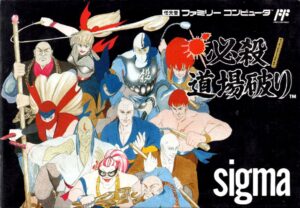Retro Replay Review
Gameplay
Teenage Mutant Ninja Turtles III: The Manhattan Project picks up where its predecessor left off, delivering familiar side-scrolling brawler action infused with fresh twists. Players choose from Leonardo, Michelangelo, Donatello, or Raphael—each boasting unique special moves that add strategic depth beyond simply button-mashing through hordes of Foot Soldiers. Whether it’s Michelangelo’s rapid nunchaku flurry or Donatello’s powerful bo staff sweeps, mastering each turtle’s strengths becomes essential for clearing tougher waves of enemies.
The level design follows a straightforward progression, guiding turtles through urban streets, sewers, construction sites, and even the Brooklyn Bridge. Hidden items and extra lives are tucked into destructible crates and breakable walls, rewarding curious explorers who deviate from the beaten path. While the stage layouts echo the formula of Double Dragon–style brawlers, the inclusion of vertical platforming sections and environmental hazards—like electrified grids and closing gates—keeps encounters from feeling too repetitive.
Combat feels punchy and responsive, with a smooth blend of light and heavy attacks. Special meters build quickly, encouraging players to unleash character-specific “super” moves to clear crowds or deal massive boss damage. Cooperative play shines as well: linking up with a friend allows for coordinated team attacks, shared power-ups, and combined tactics to take down Shredder’s toughest minions. This balance of solo and co-op options makes the game appealing for both solo enthusiasts and couch co-op sessions.
One minor quibble lies in the sometimes precise timing required to dodge projectiles or jumping enemies, which can frustrate newcomers. However, once you adjust to the turtles’ movement and attack ranges, the difficulty curve feels fair. The absence of a continues limit in some modes also encourages replayability, as players can improve their performance without the fear of a game over after one or two mistakes.
Graphics
For a Super Nintendo title released in the early ’90s, The Manhattan Project showcases colorful, hand-drawn sprites that capture each turtle’s personality and style. The animation frames are fluid, with landing punches and kicks accompanied by satisfying visual effects—such as dust clouds or starbursts—that punctuate the action. Boss characters, from Baxter Stockman’s robot mutants to Shredder himself, are rendered with impressive detail and scale, looming large over the foot soldiers they command.
The environments pop with vibrant palettes, whether it’s the murky green hues of Thieves’ Quarry or the neon-lit backdrops of Technodrome corridors. Parallax scrolling layers add depth to stages, making city skylines feel distant yet immersive. Breakable background elements—like telephone booths or subway windows—add interactivity to the settings, rewarding those who pummel their way through every corner of the level.
On occasion, enemies reuse sprite sheets, leading to moments of visual redundancy when multiple Foot Soldiers appear on screen. Yet their palette swaps—signifying different attack patterns or strengths—help differentiate them enough to keep encounters engaging. Boss stages introduce entirely new assets, ensuring that each major confrontation stands out and provides a fresh visual challenge.
The overall presentation is rounded out by crisp UI elements and readable on-screen meters. Health bars and special power gauges sit unobtrusively at the top of the screen, letting players track their status without distracting from the frenetic combat happening below.
Story
The Manhattan Project’s narrative serves as a straightforward setup to justify the turtles’ borough-spanning rampage. After Shredder’s latest scheme threatens the city, the heroes must venture from the sewers to Manhattan’s busiest streets to dismantle each piece of his plot. Though the story doesn’t break new ground, it effectively frames the action, with brief cutscenes teasing new villains and escalating stakes before each boss battle.
Character moments are sparse but charming: between levels, you’ll catch glimpses of the turtles’ camaraderie, quips about pizza, and banter that fans of the classic cartoon will appreciate. These snippets reinforce the series’ trademark humor and help break up the non-stop beat-’em-up action with lighthearted relief.
Bigger plot twists are mostly implied rather than fully depicted, so players seeking deep lore or extensive dialogue may feel the narrative is thin. However, the focus remains squarely on gameplay, and the pared-down storytelling ensures that the pace never lags. For long-time TMNT fans, the story beats hit familiar notes—Shredder’s ultimate betrayal, the Foot Clan’s relentless assaults, and the turtles’ unwavering brotherhood.
Ultimately, The Manhattan Project’s plot provides just enough motivation to power through its stages. While it won’t earn awards for narrative complexity, it stands as an effective backdrop for the turtles’ heroic exploits.
Overall Experience
Teenage Mutant Ninja Turtles III: The Manhattan Project refines the winning formula established by its predecessor, offering a polished, high-energy brawler that rewards both skill and teamwork. Its balance of distinctive turtle abilities, cooperative mechanics, and varied stage hazards keeps the action fresh across multiple playthroughs. Whether you’re tackling missions solo or pairing up with a friend, the pacing remains brisk and satisfying.
The game’s audiovisual presentation may show its age to modern audiences, but its charm lies in vibrant sprites, catchy sound effects, and an instantly recognizable TMNT atmosphere. The punishing boss battles and hidden secrets invite repeated runs, encouraging players to master each turtle’s moveset and optimize their strategies.
While the narrative may be minimalistic, it provides just enough context to motivate the levels without interrupting the flow. Fans of the Teenage Mutant Ninja Turtles franchise will appreciate the nods to the cartoon series, and newcomers can dive straight into the fun without prior knowledge of turtle lore.
In summary, The Manhattan Project stands as a quintessential example of ’90s side-scrolling beat ’em ups: easy to pick up, difficult to master, and endlessly entertaining. Its unique character powers, cooperative gameplay, and vibrant world make it a must-play for any retro gaming enthusiast or TMNT aficionado looking to relive the glory days of classic brawler action.
 Retro Replay Retro Replay gaming reviews, news, emulation, geek stuff and more!
Retro Replay Retro Replay gaming reviews, news, emulation, geek stuff and more!









Reviews
There are no reviews yet.